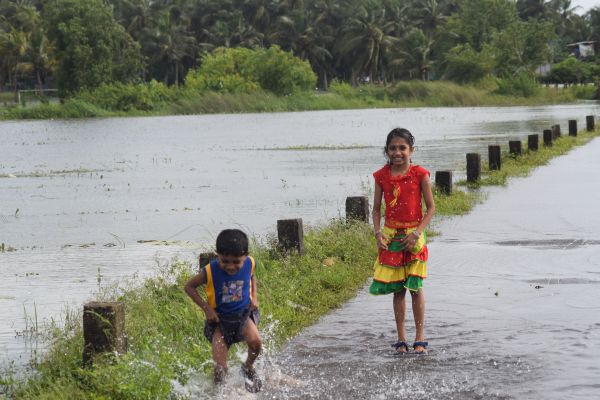Umbrella days

The long awaited monsoon sprung a surprise on us this year. It arrived three days earlier than expected.
Every year, on June 1 the monsoon arrives in Kerala, bringing with it cool winds and water laden clouds. Everyone breathes a sigh of relief as it cools the earth and replenishes water sources.
But, it is the intense heat of the summer months and the differing temperatures over land and ocean that cause the rain. The heat of the Thar Desert and the adjoining areas, generate a low pressure. During the monsoon the wind direction reverses. The moisture laden winds from the Indian Ocean blow in to fill in the void.
When the south west monsoon hits India, it splits in two because of the Western Ghats, in south central India. One part moves north towards the Arabian Sea and the coastal side of the Western Ghats. The first to experience the joy of the monsoon is the Andaman and Nicobar Islands. From there, it hits the Indian mainland along the Malabar coast. It travels on Mumbai and then Delhi and towards the Himalayas.
While the other part rolls off over the Bay of Bengal, up through Assam and hits the Eastern Himalayan range. That is, it initially tracks the Coromandel coast, north east of Kanya Kumari moving towards Orissa, swerving to the north west towards the Indo Gangetic Plain.
Typically it takes a month and a half to cover the entire country. The south of India receives more rainfall than the north. The Northeast receives more precipitation. In meteorology, precipitation is any product of the condensation of atmospheric water vapour that falls under gravity. The main forms of precipitation include drizzle, rain, sleet, snow, and hail.
After three months of rain, the country is cool and pleasant and it is time for the monsoon to bid goodbye. And, it is November.
Signs of monsoon
There are signs to predict when it will rain, how much or how little and how long. Whether they are foolproof or trustworthy is not known, but it is interesting just the same. Here are some harbingers of the rain but first, a story about writer Khushwant Singh.
The most commonly told story is of the author stopping his tennis serve mid swing and cupping his ear. As his co-players watch puzzled and impatient,he lets out a gleeful shout announcing the advent of the monsoon bird. He is said to have shouted, “”The monsoon bird is here! Hail clamator jacobinus, the monsoon is coming!”
In Andhra Pradesh, farmers watch the open bill storks. If they fly in parabolic circles, it is time to get his farming implements ready to prepare for the sowing season.
Yet another sign is the fruit of the Flame of the Forest. If the seed at the bottom has matured, it indicates that it will rain well at the beginning of the season. If the middle of the seed is matured then the middle part of the season will get good rains. Similarly, if the top is ripe then it is the end of the season that sees maximum rain. Uniformly developed seeds indicate uniform rain.
The weaver bird is also a forecaster. The quantity of rain is determined by the height of the its nest — if it is high, there will be copious rainfall, if low, then expect scant rain.
Other signs to look out for: when mangoes lose their tartness; large, black ants become frantic in their search for food; locust type insects swarm over light fixtures; the late afternoon sun turns a dirty yellow; midnight heavens thunder; peacocks dance; dragon flies crowd around; goats flap their ears, owls hoot, sheep huddle…excessively, of course; the slow red hairy caterpillar makes a dash for shelter; foxes howl from dawn to dusk.
What’s with the word?
The word monsoon comes from the Arabic word for season. There are actually two monsoons in India: the winter, or north eastern monsoon; and the summer, or south western monsoon.
There are other tropical and sub-tropical lands that have monsoons, but the Indian avatar is by far the most dramatic. This is because of India’s geographical arrangement. The large inverted triangle of land, jutting into the Indian Ocean, capped by a collar of the world’s highest mountains cannot be overlooked.
Answer these questions based on the above article.